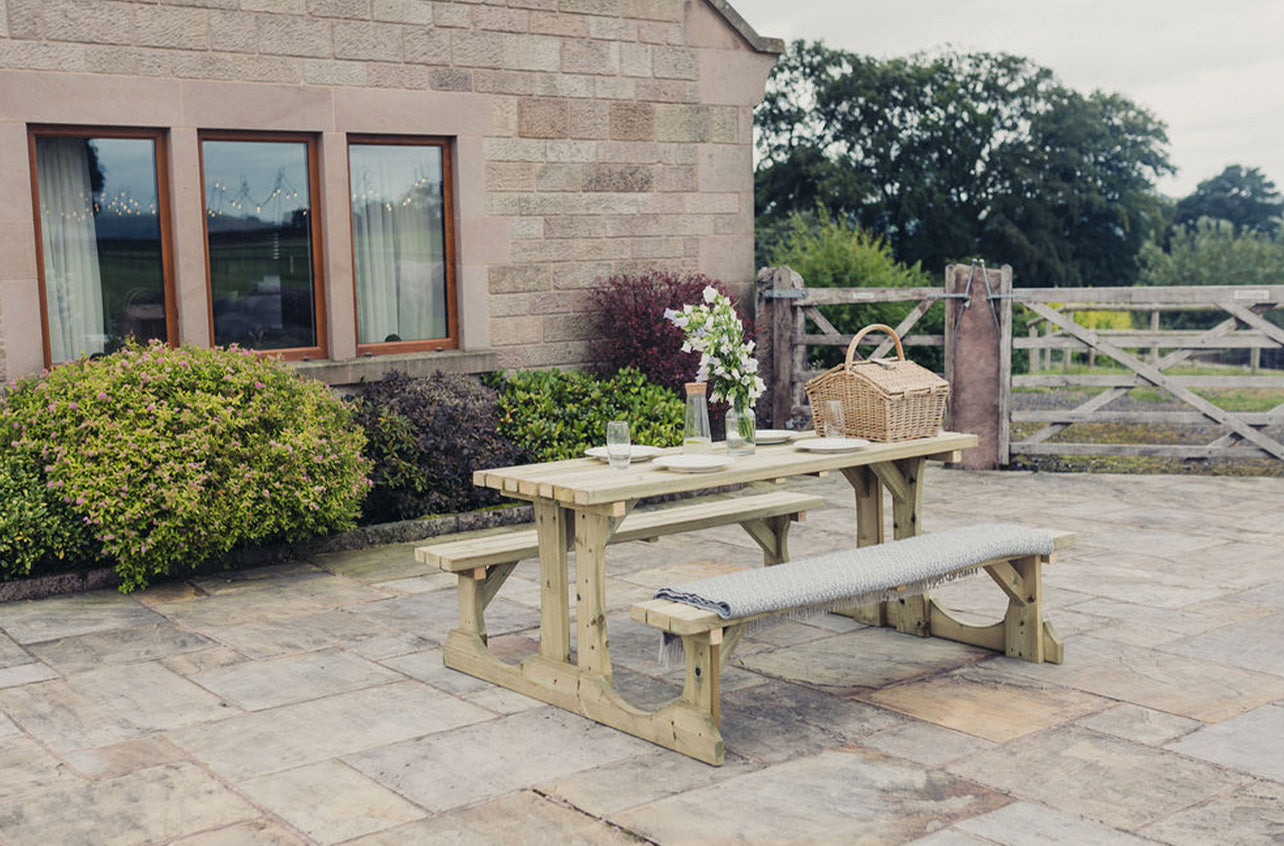Our Products
Our furniture is Eco-friendly, we only use timber from Scandinavian forests which is sustainably sourced.
The fact that we go to the extra effort of having our timber pressure treated means that it is protected against the elements for up to 20 years. A lot of the garden furniture on the market today is made to last for as little as three or four years, our products will last nearly four times as long, putting less of a strain on this beautiful planet’s natural resources.
All of our products are hand made. They are made from wood which is a natural product, so there will be natural blemishes like knots and veins through the grain, and slight imperfections like cracks or splits in the wood may occur with changes in the weather, these natural characteristics are due to the wood losing moisture during warm and dry seasons, and during exposure to intense sunlight. During colder and wetter seasons the wood will uptake moisture again which will reduce these splits or cracks. This is of no detriment to the product. We try our best to get rid of splinters and rough edges but we may not eliminate all of them.
What does pressure treatment (tanalising) do?
The pressure treatment process protects the timber against rot and decay, giving it the best possible pre-treatment available to give your product a long lifespan.
Do I have to treat the product as soon as I get it?
You don’t have to rush to add a further preservative treatment to your product as it is safe and protected from rot. Some customers decide not to treat their product at all and to just leave it to naturally weather and season. However we recommend the use of a furniture oil periodically, to help moisturise the wood and help to delay the aging process. (We do advise the use of a waterproofing product to the exterior of sheds and summerhouses if you want to avoid damp or water ingress to the inside of your building. Wood is naturally porous and the water ingress is of no detriment to the structure of the building due to the tanalising, but it can be bothersome if you are wanting to keep the inside dry)
What will happen to it if its left with just the base treatment (tanalising)?
If left untreated the wood will fade in colour turning either a light grey/silver or a darker grey in places over time. On odd occasions some parts of the timber can turn a blackish shade. Differences in how the appearance of the wood changes can depend on variables such as: location in the garden, exposure to weather, exposure or lack of exposure to sunlight and natural differences in the wood.
Why are there splits and cracks appearing?
All wood when left outside, or exposed to changes in temperature or weather conditions, will experience some splitting, warping, cracking or some other kind of movement. This is not a detriment to your product in any way shape or form and these are natural occurrences, and characteristics of having wooden garden furniture. Don’t forget guys, this is garden furniture and is meant to be stood outside for years, so please expect some weathering.
What if water gets in the splits, doesn’t this make the wood vulnerable?
If the product had not been pressure treated then the answer would be yes, mainly due to the fact that micro organisms will get into the cracks in the timber and with the mixture of water it makes the wood softer and easier for the little critters to devour.
But luckily your product has been pressure treated with Tanalith-E or Tanatone treatment, which is a copper phosphate treatment that is pumped, under pressure, deep into the grain of the timber. This treatment stops micro organisms eating the timber, yes that’s right, they won’t come anywhere near, they will have to find another picnic.
So rest assured that the splitting and cracking is perfectly fine, and these occurrences will come and go with changes in the weather.


What is normal?
These kinds of occurrences are perfectly natural and will be of no detriment to your product. If you have any concerns then feel free to add your own aftercare treatment to the timber.
What kind of wood is it, and why choose that one?
We use Scandinavian Redwood which is a naturally durable timber and is perfect for use outdoors and at the price point that we are selling our products for, it is the most expensive timber we can use. If not pressure treated the timber is prone to rot which can set in in as little as 6 months, this is why we have the wood pressure treated as if stops rot setting in for up to 20 years. Scandinavian Redwood is a soft wood, but is has a tight grain and is slow grown in the forests of Sweden, Denmark, Norway and Finland, where conditions are harsh and the trees are strong and tall, meaning the timber coming from them is also very durable and strong.
Should I add a further treatment?
If you want your product to stay looking its best and you choose not to go for the natural weathered look then it is advised that you add a further treatment to your product. Most aftercare treatments can be used on this kind of wood and we advise if unsure then asking at your local hardware store what is best to use, as it depends on the finish you are trying to achieve.
Are the dimensions given on the descriptions accurate?
All of our products are handmade, one at a time by real people in our workshop, and are made from a natural product. So it should be born in mind that the sizes and dimensions may differ slightly to those given in the product descriptions, and these should be used as a guide only. Please allow for size variances due to wet/dry timber and typically occurring differences to be expected with hand made items, especially when installing permanent bases. We would recommend allowing for at least 10cm variance as a guide.
Sheds and Buildings Aftercare
If you have acquired one of our fabulous garden sheds or buildings, you should have a friend for life. Our buildings are made to a high standard and are built to stand the test of time, but you will need to maintain your shed and look after it too.
Waterproofing
When your shed arrives you will need to paint it with a waterproof paint, wood protector or other timber care treatment. We would recommend using a spririt/oil based product.
if unsure please ask at your local hardware store or ask the company who supply the paint if it is suitable for purpose as we cannot be held responsible for use of the wrong treatment.
It is best to add two coats to ensure full protection. To fully protect your building you will need to remove the corner trims and paint the corners of the building ensuring that anywhere the wood has been cut is painting before fixing the corner trims back in place. Add extra paint around windows, doors and anywhere else that there may be open ends of the timber.
When we put your building/shed up we will put silicone sealant around the window to seal the glass in place, however, once you have fully painted it, you may need to add more silicone where you think necessary.
We recommend that you apply an extra coat of treatment every 12 months, preferably at the end of the summer or in the autumn months so that your building is fully protected ready for winter.
Preventing Damp Issues
There are a few things that you can do to prevent and minimise the damage which can be caused by moisture.
A major cause of rot in garden sheds is rising damp, this is caused by ground water being absorbed through the floor bearers and into the floor. To prevent this from happening it is best sorted during the initial planning stages of siting and building the shed. You will need a barrier between the ground and the floor of the shed, to stop the moisture entering.
How you do this will depend on what type of base you are using on which to position the shed…
Bases made using gravel allow any rain water to flow freely through it and prevent water from pooling. This reduces the chances of water being soaked up by the floor bearers.
Timber bases can be used to raise the shed completely off the ground, so that it is almost impossible for water to penetrate the floor bearers.
Concrete and paving slab bases need to be a level as possible to allow water to run off and prevent it from pooling. A shed that sits in puddled water will inevitably absorb water.
Not only can sheds suffer from ground moisture, but also from moisture in the air. This issue is particularly prevalent in Winter. Moisture, caused by damp, wet conditions can get trapped inside sheds, especially if they are not used often. If the outside temperature drops, any moisture inside the shed will cause condensation on the inside of the shed panels, roof, floor and possibly other items stored in the shed. This condensation will cause mould and mildew to form very quickly.
To combat this issue, it is advised to allow the shed to vent as often as possible throughout the winter. This will enable fresh air to circulate around the building and stop moisture from building up. To do this, you can open the windows if you have them or leave the door open from time to time. It is also a good idea to not store wet or damp items in the shed, like garden tools or bikes etc. Try to dry them off before returning them to the shed. If you do get mould forming, it is advisable to remove it as quickly as possible with an anti-mould cleaner, before it penetrates and permanently damage the timber.
Tolerances
Due to the nature of the timber and the fact that it is for use outside in a ever-changing climate that we have in the UK, we can not guarantee that items will remain perfectly straight and that warping or twisting will not happen. Also when making the products we do not focus on throwing out every piece of timvber that has a split, shake or twist in it, however, we do have tolerance levels that our operatives consider. Timber is a natural resource and these are outdoor natural products and not made from plastic or metal!
Thank you for reading.
We hope this guide has been helpful and hope you get many years of service and enjoyment out of your new product.







